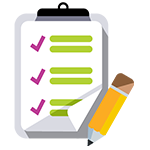Navigating Adaptive Testing: Progress Learning’s Guide for Educators and Students
Adaptive Testing – What Is It and How Is It Used?
Adaptive testing is not new for educators in the K-12 space, but it seems to be emerging everywhere lately. So what is it, and how can it affect your students and teaching?
Computer adaptive testing, or CAT, selects test questions based on the test taker’s answers to previous questions. For example, if a student answers a question correctly, the next question they see may be more challenging in some way. Alternatively, if a student answers a question incorrectly, the next question may be simpler. Researchers believe that computer adaptive testing has the potential to paint a more accurate picture of student learning than non-adaptive testing, where every student sees the same, or similar, material.
Many schools and districts are familiar with using some form of adaptive assessment for benchmark testing. NWEA MAP is an often-used growth metric that is computer adaptive. It attempts to show where students are in relation to their peers across the nation and in relation to grade-level standards that schools use multiple times over a year to track student growth.
In recent years, some states have begun to use adaptive testing not only to track student progress but for statewide assessments. Smarter Balanced assessments, used in a growing number of states, use CAT. More states, transitioning to their own state testing created with partner companies, have transitioned to computer-based testing and have begun to explore and implement adaptive tests.
This has left many educators wondering how, in the age of new and adaptive testing, they can best prepare their students for a test where it seems like the finish line is constantly moving for each student.
How Can I Best Prepare Students for Adaptive Testing?
Adaptive testing, while a fairly new concept for high-stakes testing, can be a good thing for students and educators. Benchmark adaptive assessments used throughout the year can track student growth over time more effectively than conventional tests, with more precise scores for students across a wide range of learning. This allows teachers and administrators to quickly identify the strengths and weaknesses of individual students.
Progress Learning’s Liftoff Adaptive Intervention is a great example of a powerful adaptive assessment program. Liftoff identifies academic gaps in reading and math in grades 2-8 through a variety of adaptive benchmark assessments and reports, and pinpoints specific instructional standards from previous grades that may need additional attention. Then, our intervention program uses highly engaging formats, like games, characters, and achievable and meaningful wins, to keep students authentically engaged in their learning. Liftoff also integrates with existing data from NWEA MAP. Progress scores from MAP, known as RIT scores, can be easily imported into Liftoff and used to guide student growth.
And how does this help students taking adaptive state assessments?
As more states and testing institutions make the move to computer adaptive testing, educators can embrace the more precise readings of adaptive tests. Many states are using their formal end-of-year testing to measure growth and achievement in what they hope will be a challenging yet accessible testing experience for students. Researchers and supporters of computer adaptive testing argue that it is among the fairest ways to test for student growth because the design can more accurately measure students along a range of proficiency — even if, in the case of Smarter Balance and states like Hawai’i and Arkansas, the test is only adaptive within the given grade band of the student.
Many proponents of computer adaptive testing are hopeful the test will paint a more accurate picture of student achievement and gaps in learning and curriculum, helping teachers and schools better support students. While there are some adaptive practice tests and benchmark assessments on the market already, continued practice with adaptive testing and guidance with the data will better prepare educators and students for the new world of adaptive testing.
One great way to get in the habit of using adaptive programs and their data is with Progress Learning’s Liftoff Adaptive Intervention program. Reach out to us today for more information and your free demo!


